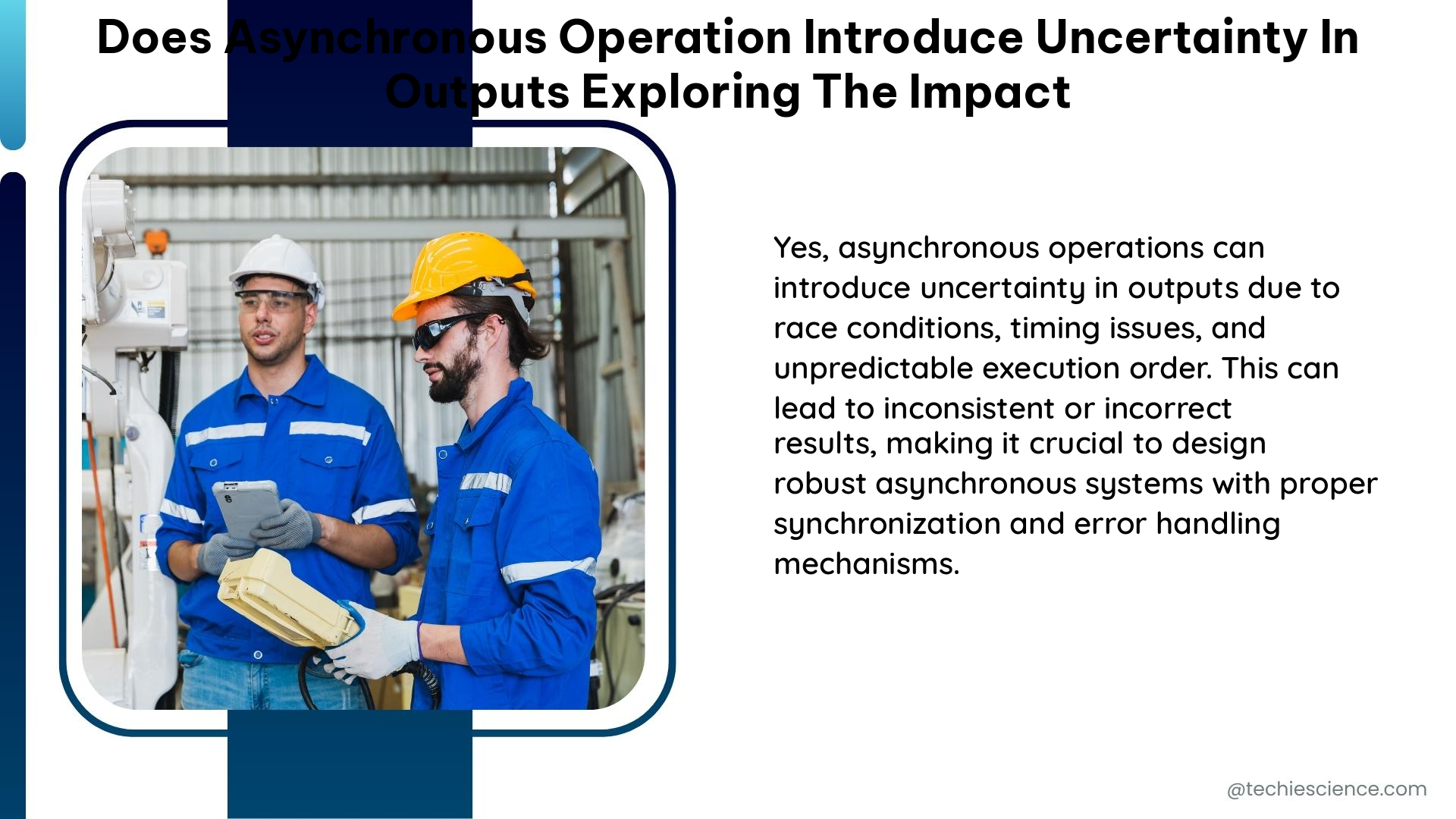Asynchronous operation, where tasks or events occur independently of a central clock or timing mechanism, can introduce significant uncertainty in the outputs of various systems and applications. This uncertainty can have far-reaching implications, particularly in the context of event prediction, time series analysis, and decision-making processes. In this comprehensive guide, we will delve into the technical details and explore the impact of asynchronous operation on output uncertainty.
Understanding Asynchronous Operation and Output Uncertainty
Asynchronous operation refers to the execution of tasks or events without a predetermined, synchronized schedule. This lack of synchronization can lead to variability in the timing and occurrence of events, which can make it challenging to make precise predictions about future outcomes. This uncertainty in the timing and sequence of events is a key factor that contributes to the uncertainty in the outputs of systems operating in an asynchronous manner.
Quantifying Uncertainty through Probability Distributions

One way to capture and quantify the uncertainty introduced by asynchronous operation is through the use of probability distributions. These mathematical models can represent the range of possible outcomes and the likelihood of each outcome occurring. Two notable examples of such models are:
-
WGP-LN (Wasserstein Gradient Prediction with Logistic Normal): This architecture models the evolution of the distribution on the probability simplex with time-dependent logistic normal distributions. It allows for the expression of rich temporal evolution of the distribution parameters, effectively capturing the uncertainty in the predictions.
-
FD-Dir (Functional Dirichlet): This model uses Dirichlet distributions to capture the uncertainty in the evolution of the distribution on the probability simplex over time. Similar to WGP-LN, it provides a flexible and expressive way to represent the temporal uncertainty in the predictions.
These models, presented in the paper “Uncertainty on Asynchronous Time Event Prediction,” demonstrate the ability to quantify the uncertainty introduced by asynchronous operation and provide a more comprehensive understanding of the potential outcomes.
Incorporating Spatial Variation and Other Factors
In addition to probability distributions, other measures of uncertainty can be employed to capture the impact of asynchronous operation. The paper “Uncertainty modeling for asynchronous time series data with incorporation of spatial variation for Land Use/Land Cover Change” discusses the use of uncertainty models that can incorporate spatial variation and other factors, such as environmental conditions, to provide a more holistic picture of the uncertainty in the data.
These models can be particularly useful in applications where the asynchronous nature of the data is influenced by spatial and environmental factors, such as in land use and land cover change analysis.
Experimental Insights and Performance Evaluation
Experimental results can offer valuable insights into the impact of asynchronous operation on output uncertainty and the effectiveness of various models in capturing this uncertainty. The paper “Uncertainty on Asynchronous Time Event Prediction” presents experiments on class prediction, time prediction, and anomaly detection, which demonstrate the high performance of the WGP-LN and FD-Dir models in capturing uncertainty in the predictions.
Similarly, the paper “Uncertainty on Asynchronous Event Prediction: Author Response” showcases the effectiveness of the UCE (Uncertainty-aware Classification with Event-based Priors) model in reducing uncertainty for categorical distributions predicted for observed data.
These experimental findings provide empirical evidence of the challenges posed by asynchronous operation and the potential solutions offered by advanced uncertainty modeling techniques.
Practical Implications and Applications
The impact of asynchronous operation on output uncertainty has far-reaching implications across various domains, including:
-
Event Prediction: In applications such as financial forecasting, weather prediction, and traffic management, the uncertainty introduced by asynchronous operation can significantly impact the accuracy and reliability of event predictions.
-
Time Series Analysis: Asynchronous data collection and processing can introduce uncertainty in the analysis of time series data, affecting the interpretation of trends, patterns, and forecasts.
-
Decision-making Processes: The uncertainty in outputs due to asynchronous operation can introduce challenges in decision-making, particularly in scenarios where precise information is crucial for making informed choices.
-
Sensor Networks and IoT: Asynchronous data transmission and processing in sensor networks and Internet of Things (IoT) applications can lead to uncertainty in the interpretation of sensor data and the effectiveness of control systems.
Understanding and addressing the impact of asynchronous operation on output uncertainty is crucial for developing robust and reliable systems across a wide range of industries and applications.
Conclusion
Asynchronous operation can introduce significant uncertainty in the outputs of various systems and applications, posing challenges in event prediction, time series analysis, and decision-making processes. By leveraging advanced uncertainty modeling techniques, such as probability distributions and spatial variation-aware models, researchers and practitioners can better quantify and manage the impact of asynchronous operation on output uncertainty. The experimental insights and practical implications discussed in this guide highlight the importance of addressing this critical issue in the design and development of robust and reliable systems.
References
- Charpentier, B., Biloš, M., & Günnemann, S. (2019). Uncertainty on Asynchronous Time Event Prediction. arXiv preprint arXiv:1911.05503v2.
- Essay.utwente.nl. (2022). Uncertainty modeling for asynchronous time series data with incorporation of spatial variation for Land Use/Land Cover Change. Retrieved from http://essay.utwente.nl/93959/
- Proceedings.neurips.cc. (2019). Uncertainty on Asynchronous Time Event Prediction – NeurIPS. Retrieved from https://proceedings.neurips.cc/paper_files/paper/2019/file/78efce208a5242729d222e7e6e3e565e-Paper.pdf
- Proceedings.neurips.cc. (2019). Uncertainty on Asynchronous Event Prediction: Author Response. Retrieved from https://proceedings.neurips.cc/paper/2019/file/78efce208a5242729d222e7e6e3e565e-AuthorFeedback.pdf
- ResearchGate. (2019). Request arrival uncertainty due to asynchronous operation and its effect on the switch configuration signals. Retrieved from https://www.researchgate.net/figure/Request-arrival-uncertainty-due-to-asynchronous-operation-and-its-effect-on-the-switch_fig4_329111296

The lambdageeks.com Core SME Team is a group of experienced subject matter experts from diverse scientific and technical fields including Physics, Chemistry, Technology,Electronics & Electrical Engineering, Automotive, Mechanical Engineering. Our team collaborates to create high-quality, well-researched articles on a wide range of science and technology topics for the lambdageeks.com website.
All Our Senior SME are having more than 7 Years of experience in the respective fields . They are either Working Industry Professionals or assocaited With different Universities. Refer Our Authors Page to get to know About our Core SMEs.